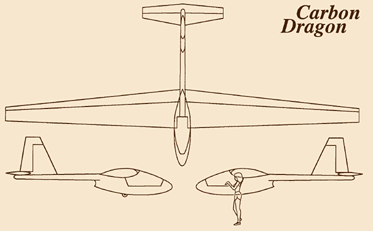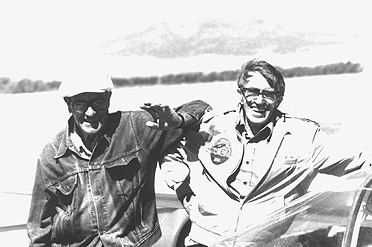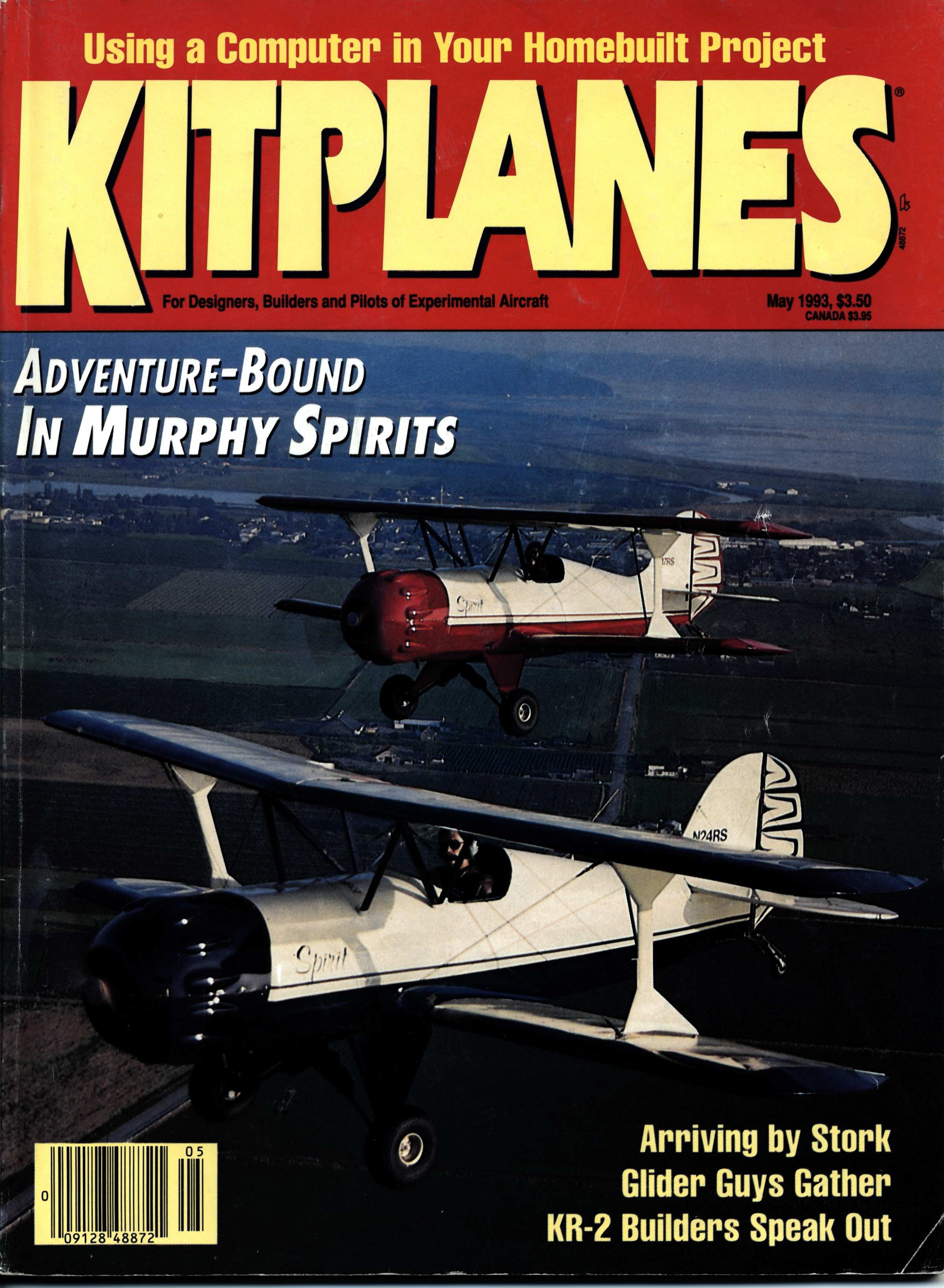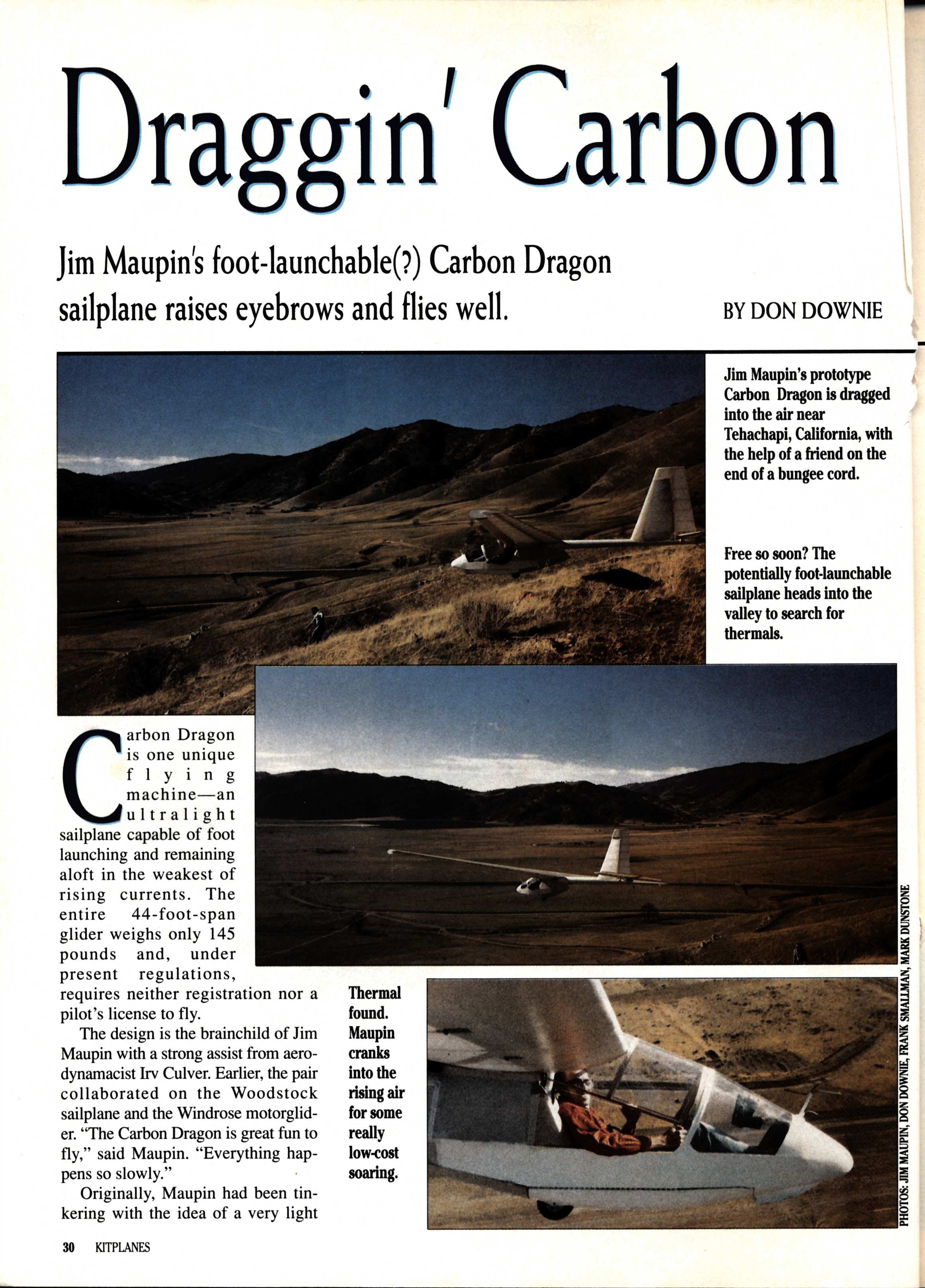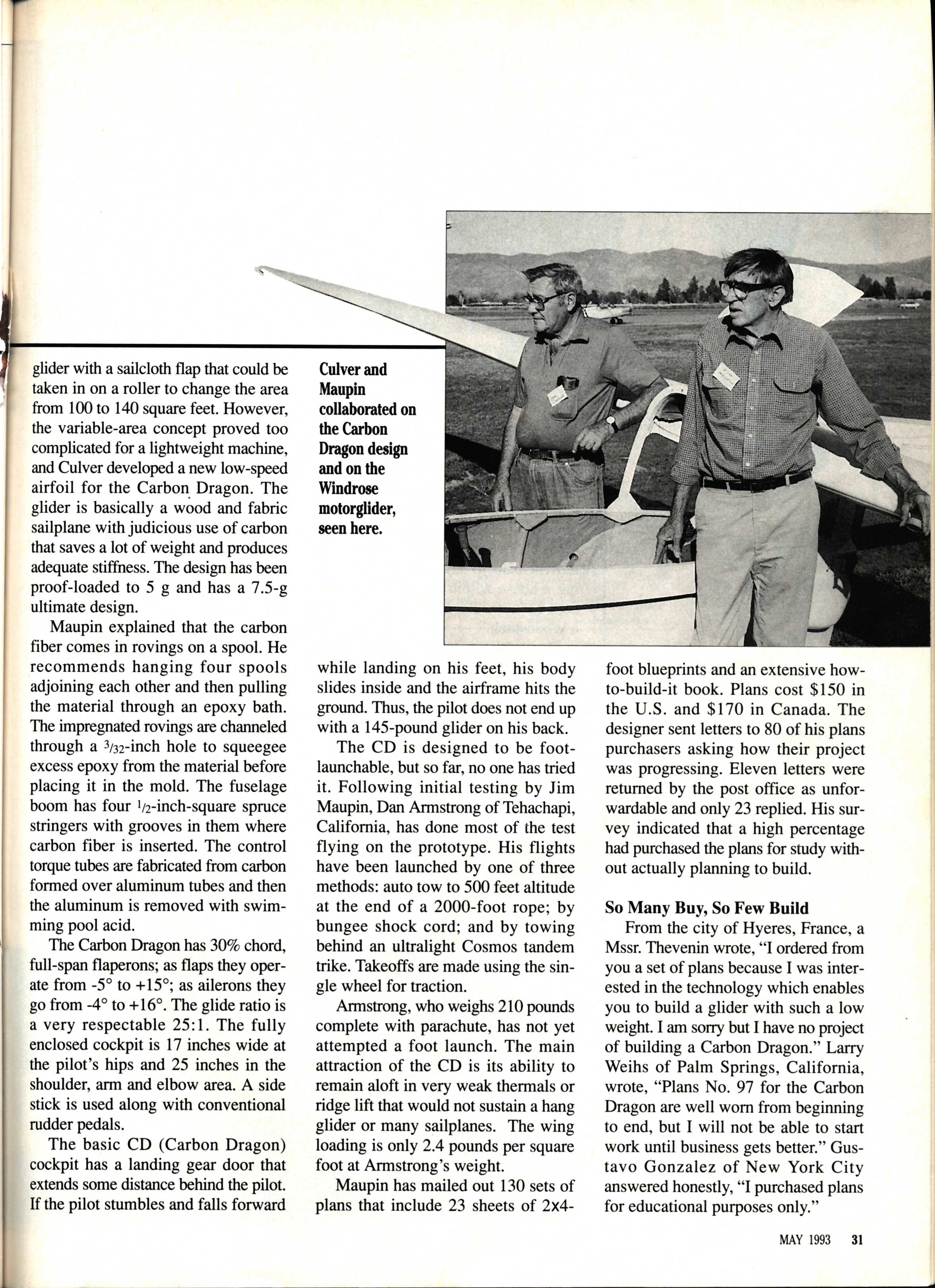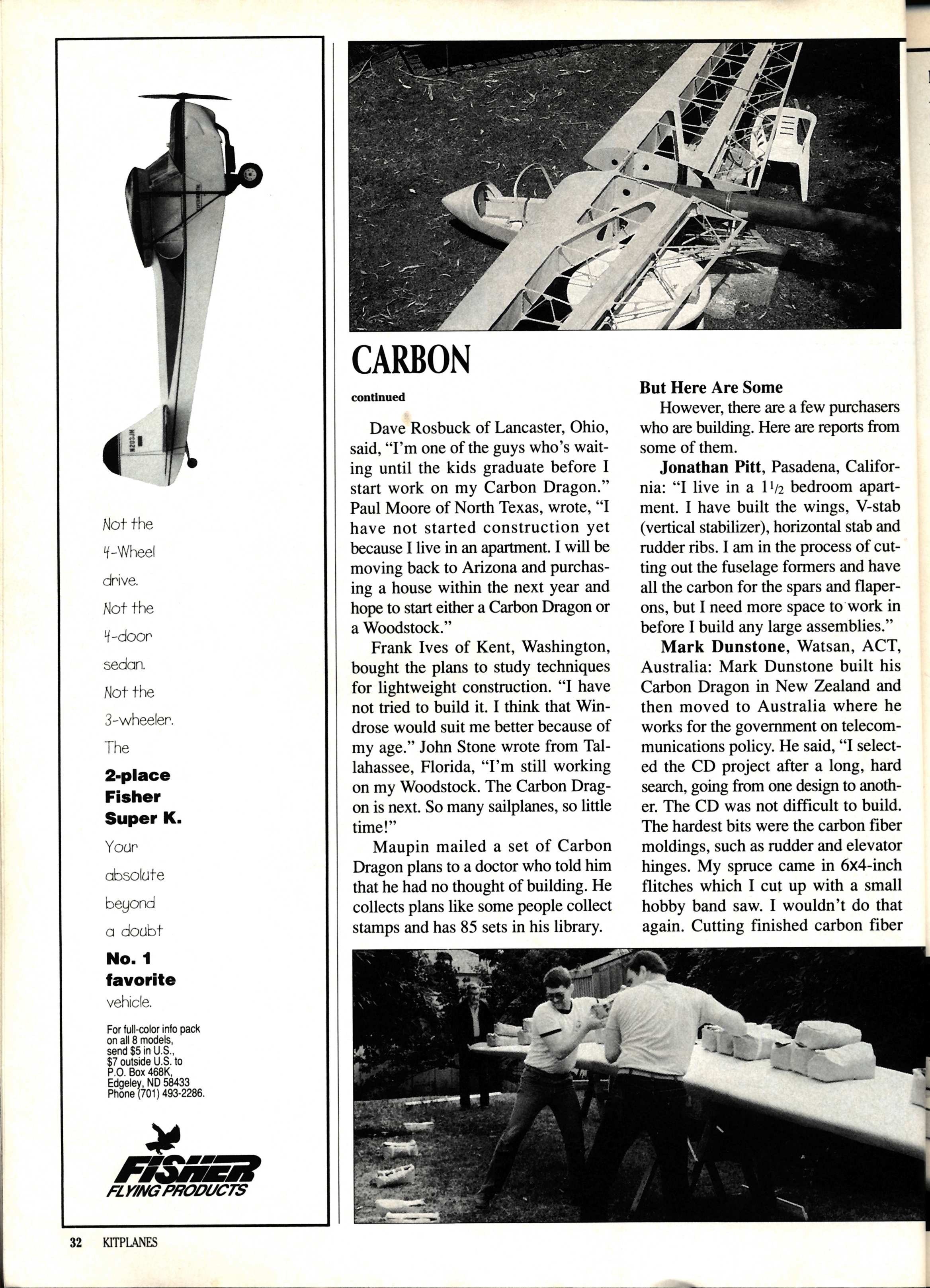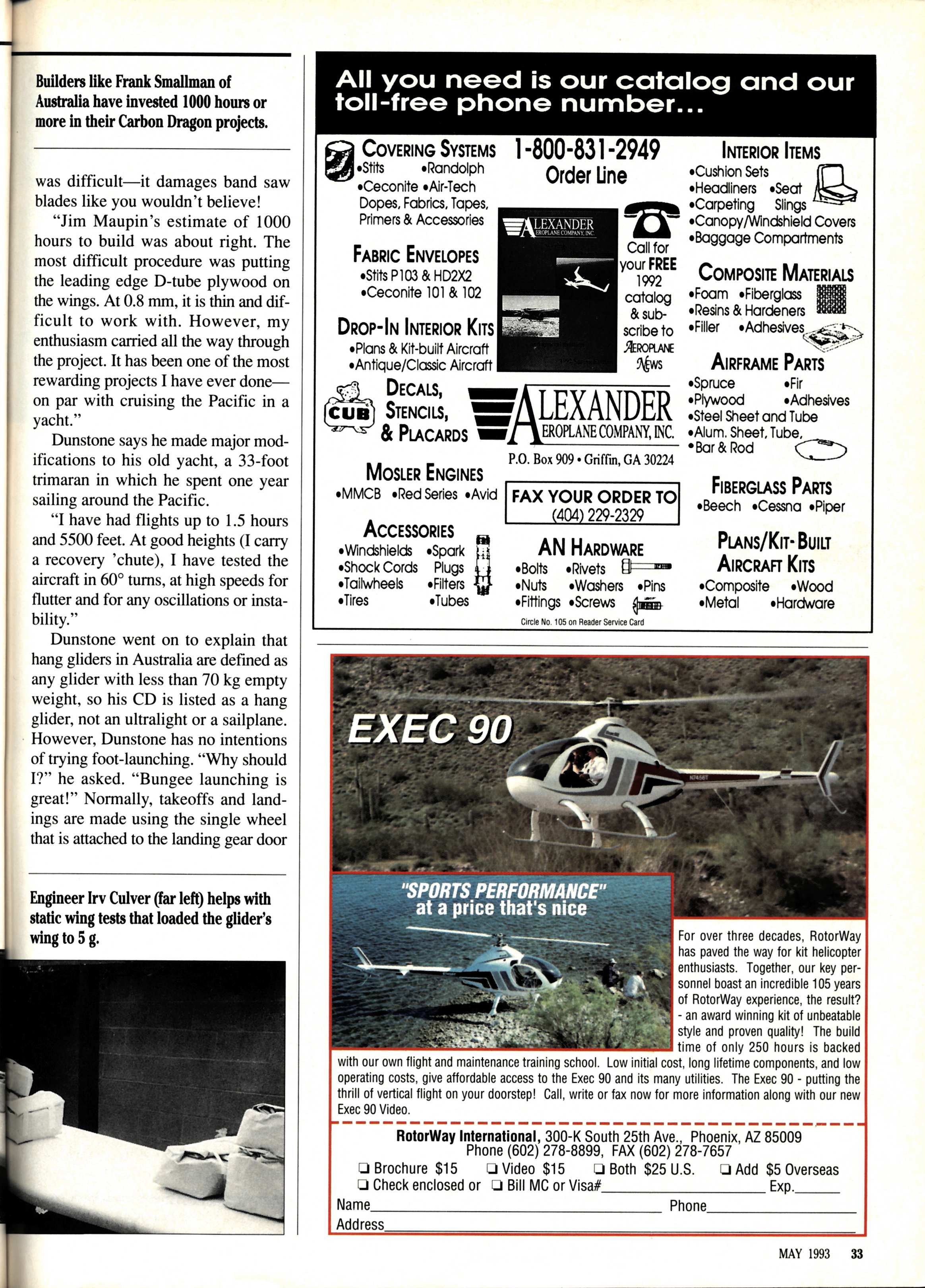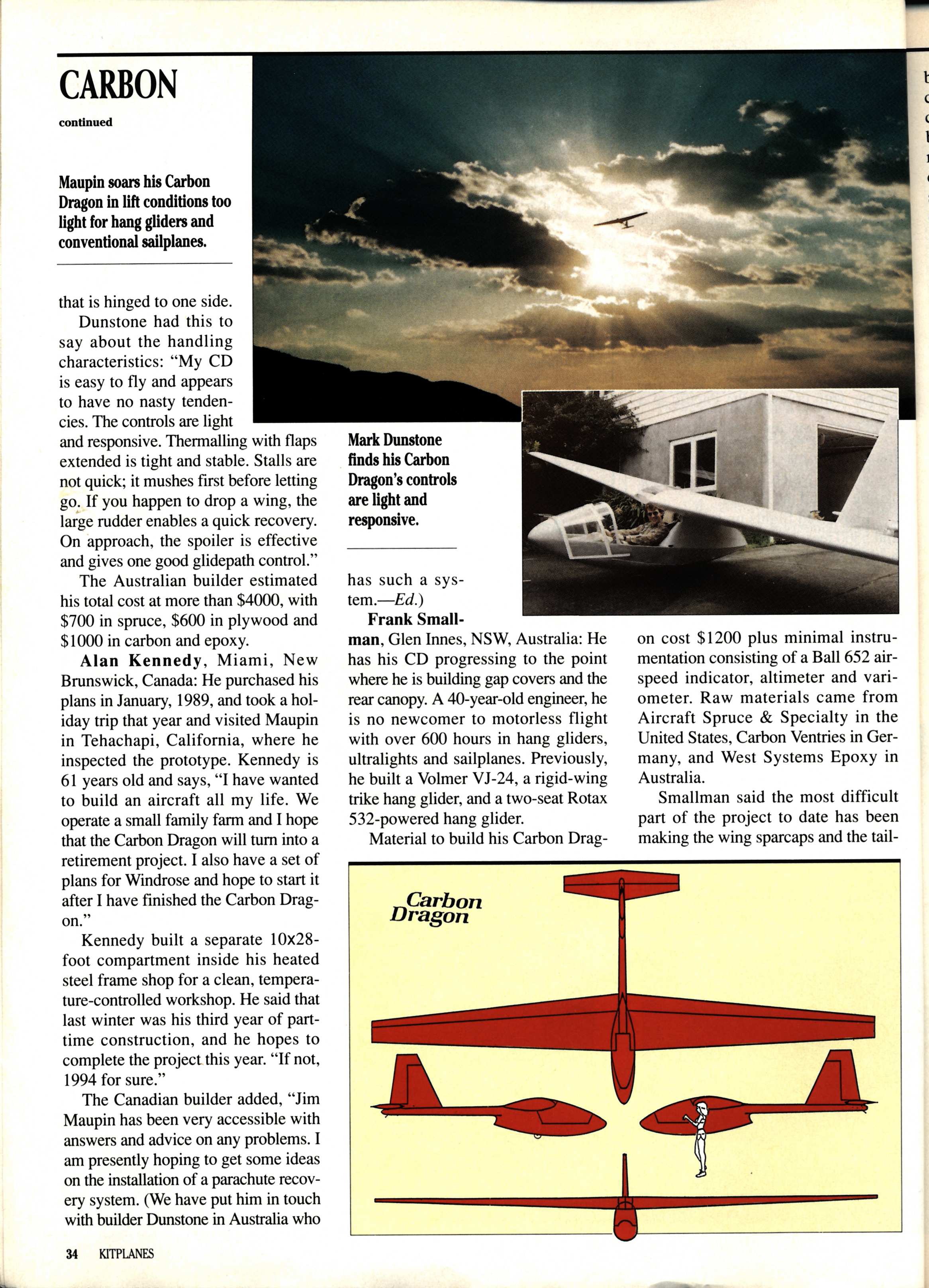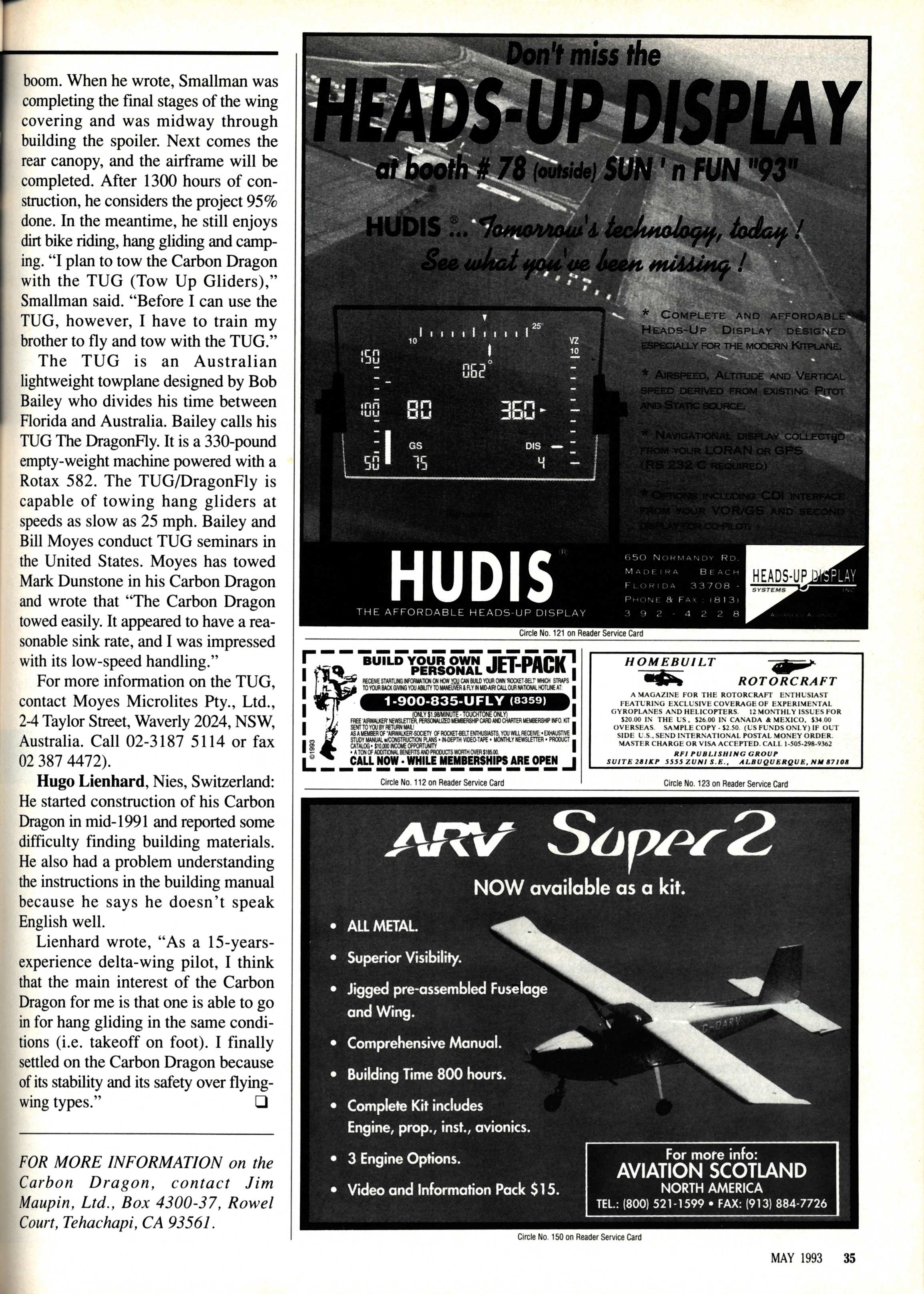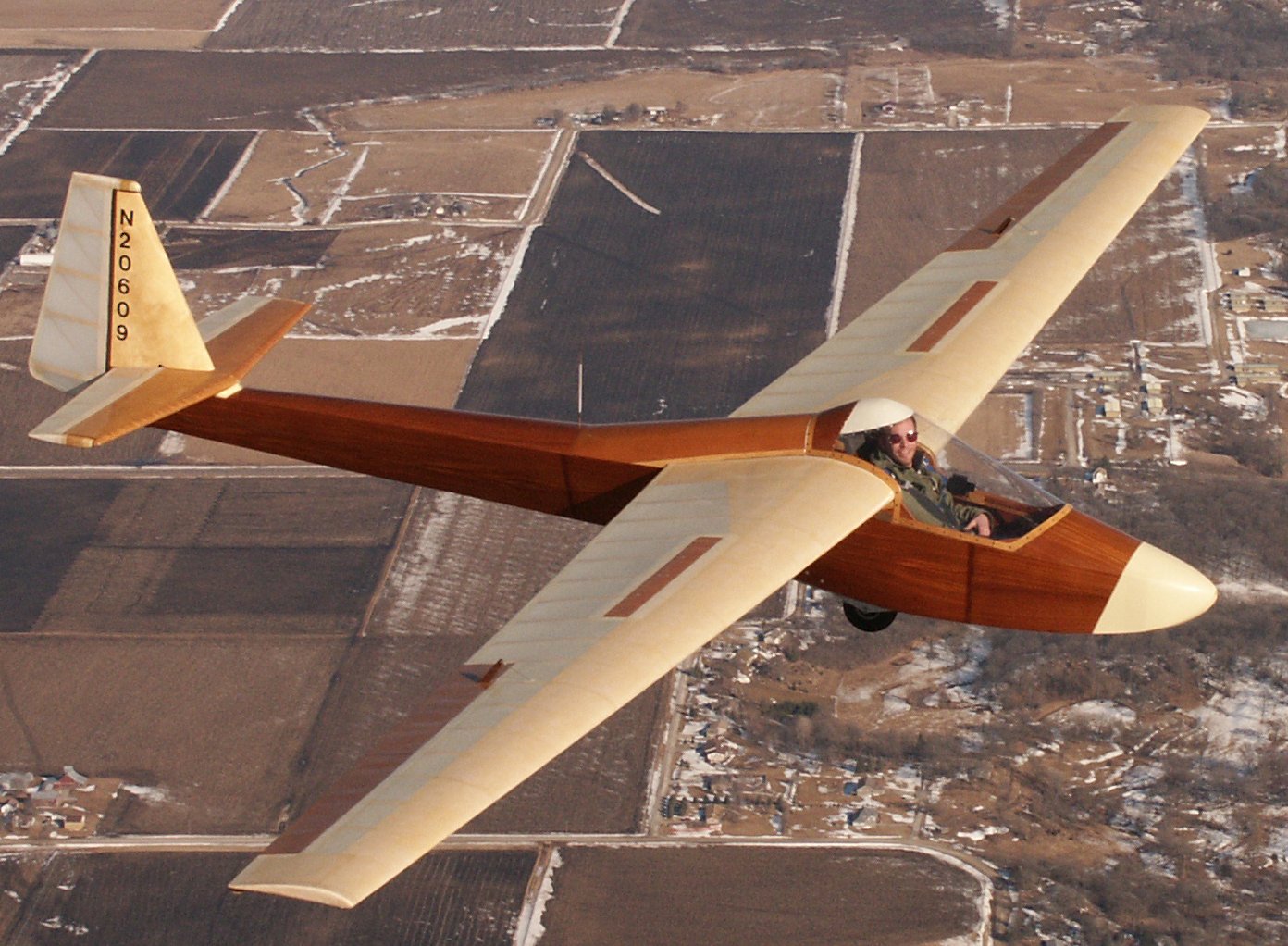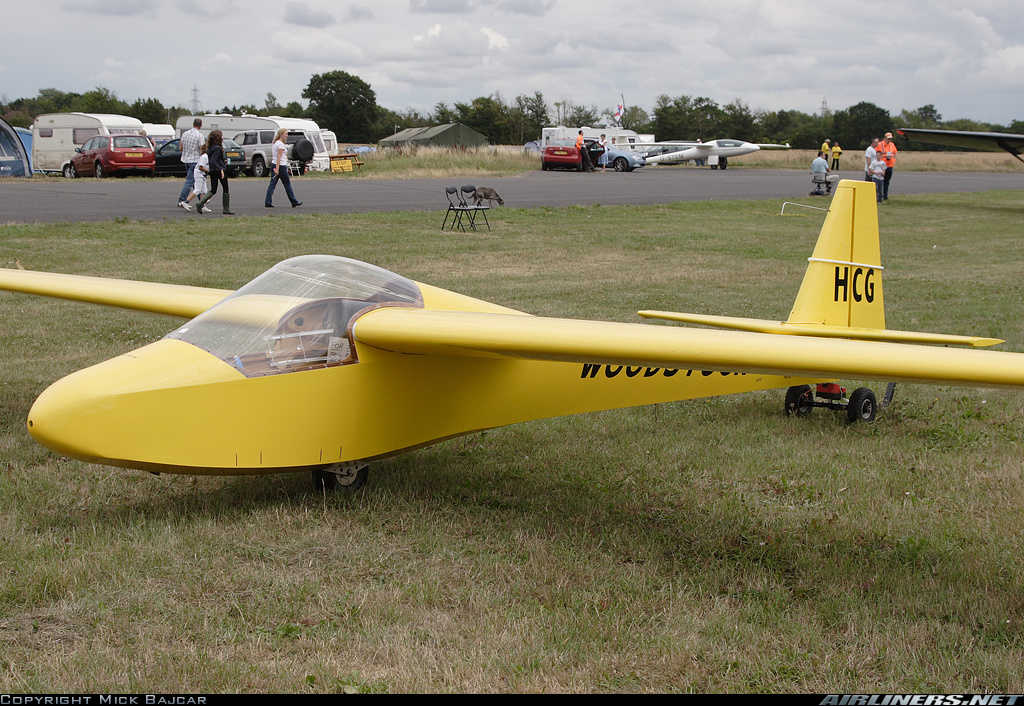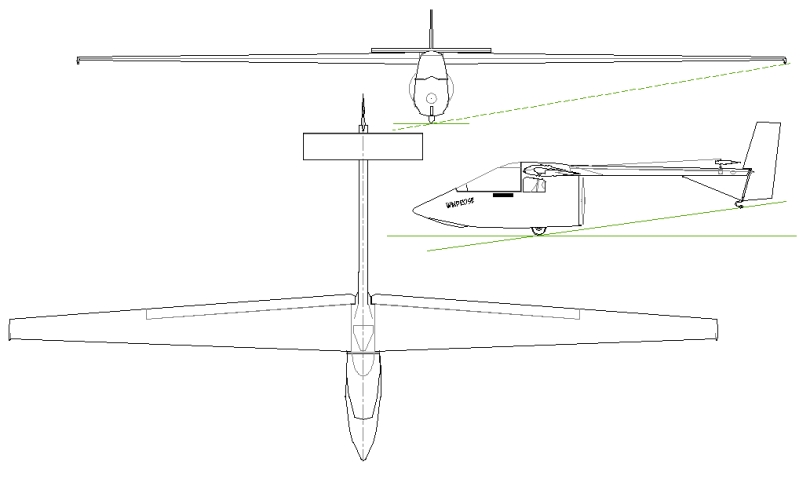Wing Stress Analysis
Transcription of Irv Culver’s Analysis for Windrose 15m:
The super Windrose wing was designed for the normal Gross Weight=700Lbs. Since the wing had good margins this analysis was written for the maximum gross of 740 lb. without reducing the load limit of 7.5 G.
(We are still calling for reduced speed [ed Vmax ] at high gross weight.
The analysis was written with varying assumptions to cover PHA and PLA conditions. NHA and NLA conditions are not critical since the wing is symmetrical structure up and down, except for the rear spar.
Also, the load factors are at +7.5 and –5.5 or 5.5/7.5=.733 or +CLmax = 1.5 and – CLmax =1 or 1/1.5=.666 and the profile angles are higher at – angles less chord load. ??
Gross Weight 740 lb.
Wing Weight 215 lb.
Corrected wing weight for the non-elliptical span wise distribution of wing weight 195 lb.
(740-195)/2=272.5 lb. Per side.
Ultimate Load Factor
=7.5G
Air Load not resisted Locally by wing inertia is 272.5 * 7.5 = 2044 lbs. Per wing.
The semi span is (6 X 47" + 10" +.25" +.8" = 293" tip to CL (Aircraft centerline).
The wing has no aerodynamic twist and the chord distribution is near elliptical so the air load will be assumed elliptical:
.42 X b/2 * air load = M CL
The wing reference plane is the mean line of the aft 2/3 of the airfoil so it conservative to assume the wing reference plane to be the 0 lift line µ L0.
The spars are normal to the wing reference plane.
The slope of the lift curve is CLµ = 2P / 1+2/A2 = 2P / 1 + 2/23.26 = 5.7857 per radian
Or 5.7857/57.3 = .100972 per degree.
Factor for use .1 CL per degree or CLµ ° = .1
CLMAX = 1.5 and 1.5/.1 = 15° = XW at CLMAX.
CDI = (1.5)2 / P * 23.26 = .03079 and .03079/1.5 * 57.3 = 1.176°
The CD0 of the wing at CLMAX is about .012 so .012/1.5 * 57.3 = .458°
1 + .176 + .458 =1.63 . .458 is a small angle and it is conservative to neglect it.
[Ed Zero Lift Drag Coefficient… per Raymer .02 for a clean propeller driven aircraft, .015 for a jet. The high aspect ratio of sailplane wing probably justifies the slightly lower assumption (& low drag of a composite?) What is happening here is looking at the lift slope at cruise and stall angles of attack, since, when the airfoil is moving forward, not all of the load is bending the wing up and down (though this is the limiting condition to be tested), some of the force is pushing forward creating tension loads on the rear fitting. Since this is determined by the lift angle (15° ), it actually acts as a net force trying to rotate the wing about its CL; but the application is still tension on the rear fitting..]
So the normal component is
cos 15° = .966
and the forward component is
sin 15° = .259
Angles relative to the reference plane.
So the normal to the airstream ultimate moment at the CL is .966 * 2044 * 293 * .42 = 242,982 inch lb.
The Chordwise Ultimate moment at the CL is .259 * 2044 * 293 * .42 = 65,147 inch lb.
To account for the Rolling pull out at higher G’s the moment distribution is conservatively assumed to be that for rectangular distribution reference the plan view of the wing.
The fitting normal moment is 242,982 * (293 –5 / 293)2 = 234,749 in lb. At the CL fitting
The Normal moment at the outboard side of the inboard rib is 242,982 * (293 10.25 / 293)2 = 226279 in lb.
The normal moment at A [first foam 47" joint]:
is 242,982 * (293 10.25 / 293-47)2 = 157,305 in lb.
The normal moment at B [second foam 47" joint]:
is 242,982 * (293 10.25 / 293-(47 * 2))2 = 100,835 in lb.
The normal moment at C [third foam 47" joint]:
is 242,982 * (293 10.25 / 293-(47 * 3))2 = 56,870 in lb.
The normal moment at D [fourth foam 47" joint]:
is 242,982 * (293 10.25 / 293-(47 * 4))2 = 25,409 in lb.
The normal moment at E [fifth foam 47" joint]:
is 242,982 * (293 10.25 / 293-(47 * 5))2 = 6,453 in lb.
The ratio of the moments is:
Forward chord load 65147 / Normal chord Load 242982 = .268
So we can multiply the wing up bending * .268 to get chord loading.
Root rib chord loading:
226279 * .268 = 60,643 in. lb. ultimate chord loading.
Distance from CL front spar to rear wing fitting is 15".
60,643/15 = 4043 lb. tension on rear fitting. Note the shear from the root rib in the fore and aft direction is taken by the front spar. The rear spar has essentially 0 stiffness in this direction, relative to the front spar, inboard of the root rib.
Chord Bending Moments
:
[this is the part of the load trying to bend the wing, ie carrying the "weight" of the ariframe plus G forces]
M at the root rib = 60643 in.lb.
M at A 157,305 * .268 = 42,158 in. lb.
M at B 100,835 * .268 = 27,024 in. lb.
M at C 56,870 * .268 = 15,241 in lb.
M at D 25,409 * .268 = 6,810 in. lb.
M at E 6,453 * .268 = 1,729 in. lb.
The Dimensions from the CL of the front spar to the CL of the rear spar are (x)
|
(x)
|
M/(x) tension
|
Cap Area Rear Spar
|
Rear Spar Stress tension psi
|
|
Root Rib
|
14.65"
|
4139 lb.
|
.375
|
11037 psi
|
|
A
|
12.9"
|
3268 lb.
|
.105
|
31124 psi
|
|
B
|
11.15"
|
2424 lb.
|
.082
|
29561 psi
|
|
C
|
9.33"
|
1634 lb.
|
.071
|
23014 psi
|
|
D
|
7.52"
|
906 lb.
|
.053
|
17094 psi
|
|
E
|
7.6"
|
228 lb.
|
.024
|
950 psi
|
The (tabled above) Rear spar tension stress assumes that the skins, foam, etc. do not carry any load. The front spar must carry the (compressive stress for bending
)? [At the end of the calculations, we make an attempt to estimate the magnitude of this part of the safety factor.]
Spar assumption ½ Upper and ½ Lower cap area.
[As the distance between the surface of the cap & the skin becomes greater, a beam flange carries less of the surface load and become more a component of the shear web. The assumption is that the bottom half of each beam, acting with the dowels (we’ve neglected the foam, remember?) is the shear web of the composite beam, with the top halves being the flange. For the same effect, imagine a solid beam with lightening holes drilled in it. In fact, of course, the more the composite beam deflects, the greater force this additional material can assume…it may have no function under normal conditions but prevent absolute fracture under overstress conditions.]
Main Beam cap load
|
Thickness
H"
|
A (sq. in.)
|
M ultimate
|
Mean Stress
F = M/HA
|
Rear Spar loads are also compression in front spar.
|
Compressive Stress
|
|
Root Rib
|
5.7"
|
2
|
226,279
|
19,849
|
1035
|
E = 20,884
|
|
A
|
4.9"
|
.72
|
157,305
|
42,804
|
2269
|
E = 45,073
|
|
B
|
4.1"
|
.55
|
100,835
|
44,726
|
2203
|
E = 46,919
|
|
C
|
3.3"
|
.39
|
56,870
|
44,188
|
2095
|
E = 46,223
|
|
D
|
2.5"
|
.24
|
25,409
|
42,348
|
1881
|
E = 44,229
|
|
E
|
1.7"
|
.17
|
6,453
|
22,328
|
671
|
E = 22,999
|
H is the distance between the CL of the caps vertically, so the stress is mean stress. Mean stress is what we are interested in for elastic stability of the cap. Cap slope is .8"/47" = .01702 radians, front view angle between CL upper cap and CL lower cap.
Peak fiber stress
is h/H where h is the overall height of spar.
|
h
|
H
|
h/H
|
f
|
FOF= h/H X f
(outer fiber stress)
|
Stress Chord bending psi
|
E outer fiber stress psi compression
|
|
Root Rib
|
7.75"
|
5.7"
|
1.36
|
19,849
|
26,944
|
1035
|
28,029
|
|
A
|
5.75"
|
4.9"
|
1.173
|
42,804
|
50,209
|
2269
|
52,478
|
|
B
|
4.84"
|
4.1"
|
1.18
|
44,716
|
52,787
|
2203
|
54,990
|
|
C
|
3.93"
|
3.3"
|
1.19
|
44,188
|
55,583
|
2095
|
54,678
|
|
D
|
3.01"
|
2.5"
|
1.20
|
42,343
|
50,817
|
1281
|
52,698
|
|
E
|
2.10"
|
1.7"
|
1.15
|
22,328
|
25,677
|
671
|
26,348
|
Carbon epoxy with reasonable workmanship results in compression allowables of at least 65,000 psi in bending & compression, ultimate.
[ For Carbon fibers in vacuum bagged layup, Holloman reports 130,000 tensile ultimate strength, 72,000 compressive ultimate strength. For Hand Laid UP E-Fiberglass Unidirectional ( used in spar caps of the lower aspect ratio wing & as reported to the SHA & tested without posts) he reports 70,000 tensile ultimate strength and 43,500 compressive ultimate strength Carbon is "twice" as good. These are relatively thin material sections, reported by physical test. The difference between the calculated stress & the rela stress of the materials is a significant part of our safety factor.]
Compression:
Cap Stability:
The compression cap is stabilized by the skin in the fore and aft direction. The Z direction is stabilized by posts through the foam between the upper and lower caps, and by the foam between the supports. Some years ago we built a test wing with no posts, just foam. This was the low aspect ratio wing; it carried ultimate with no posts…
(Paper describing this test is referenced)
Compression load:
PC = P 2ECI / L2 + EFWL2 / hP
So we must evaluate the second post of station D. EF = 10,000psi.
The effect of the force is: 10,000 X .489 X 34.5 / 2.05" X P 2 = 8,338 lbs.
PC = 8,239 + 8,338 = 16,577.
The axial load …is 10,615 at D so 16,577/10,615 –1 = .56 margin.
This is conservative since we used the width of the cap for W instead of analyzing to find effective W.
[ Because the cap is directly bonded to a relatively thick skin on the top surface, the effective W of the top & bottom of the beam flange in carrying loads is somewhat greater than the width of the carbon itself. Imagine the wing carrying some sandbag weights with NONE actually applied to the area over the cap]
Compression load in posts (note the tension CAP is the same as the compression cap).
EC = 6,000,000. The crushing load per running inch is f2 X 2 Acaps/Ech
The distance between posts is 5.875"
So f2 * 2 AC * 5.875 / EcH = compressive load in posts.
|
fMEAN
|
ACAPS
|
H
|
F2 X AC /HEc
|
Ult Crush load on posts A*8*2* 5.875
|
|
Inboard Rib
|
19,849
|
2
|
5.7"
|
23.0
|
270.25
|
|
A
|
42,804
|
.72
|
4.9"
|
44.9
|
527.6
|
|
B
|
44,716
|
.55
|
4.1"
|
44.7
|
525.2
|
|
C
|
44,188
|
.39
|
3.3"
|
38.5
|
452.4
|
|
D
|
42,348
|
.29
|
2.5"
|
28.7
|
334.9
|
|
E
|
22,328
|
.17
|
1.7"
|
14.1
|
165.7
|
Shear in Skin:
We are using very conservative shear distribution span wise. Assuming that the shear is proportional to the span:
b/2 =293" and the distance from CL to the outboard side of the inner rib is 10.25". So shear at CL = 2044 lbs. ultimate. Shear at inner rib is 2044 * (293-10.25)/293 = 1973 lb.
We will conservatively use the distance between the CL of the caps h as the effective height. The external shear is:
|
shear
|
h
|
S/h
|
|
Inner Rib
|
1,973 lb.
|
5.7"
|
346
|
|
A
|
1,644 lb.
|
4.9"
|
336
|
|
B
|
1,315 lb.
|
4.1"
|
321
|
|
C
|
987 lb.
|
3.3"
|
299
|
|
D
|
658 lb.
|
2.5"
|
263
|
|
E
|
329 lb.
|
1.7"
|
188
|
The shear carried by the spar cap slope is µ SC + 5.7 – 4.9 /47 = .01702 inner rib to A.
This slope is constant over the spar so the shear carried by the slope of the spar cap is
µ SC = M/h = D Shear internal
|
M
|
h
|
M/h * .01702
|
D Shear = shear/h
|
|
Inner Rib
|
226,279
|
5.7"
|
676
|
-119
|
|
A
|
157,305
|
4.9"
|
546
|
-111
|
|
B
|
100,835
|
4.1"
|
419
|
-102
|
|
C
|
56,870
|
3.3"
|
293
|
-89
|
|
D
|
25,409
|
2.9"
|
173
|
-69
|
|
E
|
6,453
|
1.7"
|
65
|
-38
|
E shear flows
|
External shear Flow
|
Internal Shear Flow
|
E Vertical shear flow
|
Skin shear from vertical shear
|
|
Inner Rib
|
346
|
-119
|
227
|
113.5
|
|
A
|
336
|
-111
|
225
|
112.5
|
|
B
|
321
|
-102
|
219
|
109.5
|
|
C
|
299
|
-89
|
210
|
105
|
|
D
|
263
|
-69
|
194
|
97
|
|
E
|
188
|
-38
|
150
|
75
|
The wing has two shear paths (fore and aft) so the skin shear is vertical shear/2.
Torque shear flow. The enclosed areas of the wings are:
|
Area of wing
|
2 * area
|
|
Inner Rib
|
149 in sq.
|
298
|
|
A
|
105 in sq.
|
210
|
|
B
|
79 in sq.
|
158
|
|
C
|
58 in sq.
|
116
|
|
D
|
44 in sq.
|
88
|
|
E
|
23 in sq.
|
46
|
The shear center of the wing is at approx. 1.5" aft of the spar caps for the entire span. This is at 37.5% of chord at root and 40% at the tip.
To be conservative, use shear center at 40% over the entire spar, and CP at .25C. .4-.25 = .15C.
Note PLA condition is not critical since the CM = .003 so the CP is not at 40% when pulling G’s at high speed.
The Chord At the stations =C
|
C
|
a=C * .15
|
D T=329 * a
|
S D T in Lb.
|
2A
|
S T/2A
|
|
Root Rib
|
34.6"
|
5.19
|
1,708
|
7,858
|
298
|
26
|
|
A
|
31.8"
|
4.77
|
1,569
|
6,150
|
210
|
29
|
|
B
|
29"
|
4.35
|
1,431
|
4,586
|
158
|
29
|
|
C
|
26"
|
3.9
|
1,283
|
3,155
|
116
|
27
|
|
D
|
21.9"
|
3.29
|
1,082
|
1,872
|
88
|
21
|
|
E
|
16"
|
2.4
|
790
|
790
|
46
|
17
|
D shear is 1973/6 = 329 per station for the conservative rectangular loading,
so the LE skin shears are
|
Vertical shear flow
|
Torque shear flow
|
S LE shear flow lbs. in.
|
|
Root Rib
|
113.5
|
26
|
139.5
|
|
A
|
112.5
|
29
|
141.5
|
|
B
|
109.5
|
29
|
138.5
|
|
C
|
105
|
27
|
132
|
|
D
|
97
|
21
|
118
|
|
E
|
75
|
17
|
92
|
The skin is designed for ground handling & is good for over 400 lb. Per" running shear.
[the point here is that if you design to prevent hanger rash & kiddie handprints then you are heavier than one needs to be for air loads.]
We will not reduce the shear due to torque aft of the beam caps to account for of aileron deflection during High G (rolling Pull out).
Skin shear due to forward chord loads.
We will assume 60% in lower skin & 40% in upper skin, or invert if critical. From prior table the ratio or shears is .259/.966=.268
|
a
|
a * .268
|
x front to rear spars
|
shear flow 100%
|
shear flow 60%
|
shear (table)
|
S shear flow aft of spar
|
|
Root Rib
|
1,973
|
529
|
14.65"
|
36
|
22
|
113.5
|
135.5
|
|
A
|
1,644
|
441
|
12.9"
|
34
|
20
|
112.5
|
132.5
|
|
B
|
1,315
|
352
|
11.15"
|
32
|
19
|
109.5
|
128.5
|
|
C
|
987
|
265
|
9.33"
|
28
|
17
|
105
|
122
|
|
D
|
658
|
176
|
7.52"
|
23
|
14
|
97
|
111
|
|
E
|
329
|
88
|
7.6"
|
12
|
7
|
75
|
82
|
|
|
|
|
|
|
|
|
Values compare to 400 lb. per in.
Fasteners:
The Net Spar Cap Area at the two outer bolts is:
1" X 2" –[(.375 * 1)*2] = 1.25 sq. in.
Tension side member stress is
39,530/1.25 = 31,624 psi ultimate.
The 2 outer bolts of the front spar fitting are .375 Dia or .1875 radius
I = P R4/4 = P * (.1875)4/4 = .00097
Allowable ultimate bending is 145,000 * bending form factor of 2 = 290,000psi
The Cap is 1"wide with .125 plywood on the sides, allowing for bearing on the fitting .05" the moment is PU/2 * (1/4" + .125 +.05)=M or PU * .2125 =M
So MR/I = PU * .2125 * .1875/.00097 = 290000
or PU = 290,000 * .00097 / .2125 * .1875 = 7,060 lbs. per Bolt.
CL Bolts for Disassembly
h = 6" Vertical distance between fastener bolt
Dia = .75" R=.375"
Area = .441 sq in.
I = .01553
the compression load from chord bending will be divided 50% upper & 50% lower, since the upper bolt is displaced up. The lower bolt is also slightly afore the mean line of the lower cap.
Upper bolt load 234,759/6=39,127+4,139 * .5 = 41197 lb.
Lower Bolt Load 234,759/6 = 39127 – 4139 * .5 = 37058 lb.
Tension on legs of lower fitting
.
two fittings fore and aft so 37,058 lb/2 = 18,529 lb. tension load.
[drawing]
area is 2 * .7 * .25 = .35 sq. in.
18529/.35 = 52,940 psi at ultimate.
Normalized 4130 = 90000 ultimate 90000/52940 – 1 = .7 margin.
at limit load 52940/1.5 = 35293psi. with a stress concentration factor of 2.5 the bending part is 1.5 the form factor for rectangular sections in bending is 1.5 so
1.5/1.5 * 35,293 = 35, 293 so 35,293 + 35,293 = 70,586psi
Main fitting bolts at CL
.75 Dia R=.375
Upper Bolt Load = 41,197
2 shear planes so 41,197/2 = 20,599 lbs.
area is P * (.375)2 =.44 sq in.
20,599/.44 = 46,816 psi OK
or the bolt is good for 33,000 lb ultimate
33,000/20,599 – 1 = .60 margin
Rear Beam Fitting
ultimate chord bending moment 60,642 in lb
15" CL front spar to rear spar
60,642/15" = 4043 lb tension
torque at root rib 7858 lbs
7858/15" =524 lb shear
[drawing]
horizontal forces only are treated.
4043 * .25 / 2" = 505 lbs tension in upper cap and
4043 –505=3,538 lbs tension in lower cap
vertical force moment resisted by horizontal force
524 * 3.3"/2" =865 lbs.
865 lbs. compression in upper cap
865 lbs tension in lower cap
S upper cap load 505 –865 = 360 lbs compression
S lower cap load 3538 + 865 = 4403 lbs tension
tear out in lower cap
4 X 8" X .5 = 3.2 sq in shear
at load 4403 lbs
so 4403 /3.2 = 1,376 psi shear in carbon epoxy cap (OK)
if fitting on aft side only
then 1,376 X 2 = 2752psi (OK)
tear out shear allowable = 4,000 psi.
Upper cap tear out OK
Lower cap bolts
4043/4 bolts = 1101 lbs per bolt.
in shear for ¼" bolts shear allowable = 3600 (OK).
3/8 pin allowable shear [(4043)2 + (425)2]1/2 = 4077lb
4077/2 = 2039 lb
allowable shear 5400 lbs OK
note: vertical shear force can be taken by the center bolts into the plywood.
tension stress in carbon epoxy lower cap. The cap is .5" wide and .25" deep.
,85*.5 = .425 sq in.
the first bolt removes .25 * .5 = .125 sq in.
E = ,425-.125 = .3sq in
so 4403/.3 = 14677 psi ) ok
the vertical load was transferred to the center of the fitting in the former analysis.
now we must transfer it 2"more to the root rib.
524 * 2" / 2" = 524 lb D compressions in the upper cap and tension in the lower cap.
So the cap loads at the root rib are:
upper cap load = 360 + 524 = 884 lbs compression
lower cap load = 4403 + 524 = 4927 lb tension.
The upper cap load must be taken in the skin of the wing in 47" or less because the upper cap fades out in the first foam block.
884/47 = 19lb per inch, use 25 for the possibility of the notch not being full outboard in the tapered out region. The shear flow 135.5 from prior plus 24 = 161 shear in skin assuming the shear adds and goes one direction only. The allowable shear is 400 lbs in.
Tension in rear beam attach lug
fitting is .25 in thick
area is .4 X .25 X 2 = .2 sq. in.
P/A = 4077/.2 = 20,385 psi OK
Rear Beam fitting on fuselage
M = 4077 X 1.2" = 4,892 in lb.
I = .187 * (1.75)2 / 12 = .0835 and .0835 X2 = .167 = I2
MY/I = 4,892 * .875 / .167 = 25632 psi OK
Aadditional stuff:
Analysis of bending in wings – deflection predictions for proof loading tests.
Method 1 (Mohr’s Method): Method of elastic weights.
Method 2 (Greene): Moment area method.
Assumptions:
Fuselage Loads Moved to root ribs.
Moment loads averaged for wing sections, ie. section A – root rib to Station A (47") is Root load Plus ½ Station Load. Section B = ½ Station A load Plus ½ Station B load. This will reflect ability to place physical loads (sandbags or equal).
Calculated deflections are actually deflection of root rib "attach points" for imaginary beam supported at midpoint; (method per Bruhn).
Gross Weight 740 lb.
Wing Weight 215 lb.
Corrected wing weight for the non-elliptical span wise distribution of wing weight 195 lb.
(740-195)/2=272.5 lb. Per side.
Ultimate Load Factor
=7.5G
Air Load not resisted Locally by wing inertia is 272.5 * 7.5 = 2044 lbs. Per wing.
4088 lb. total.
STATUTORY Aerobatic loading = 6G
Air Load not resisted Locally by wing inertia is 272.5 * 6.0 = 1635 lbs. Per wing
3270 lb. Total.
"HIGH PERFORMANCE SAILPLANES" (Per Thurston, Design for Flying) 5.33G
Air Load not resisted Locally by wing inertia is 272.5 * 5.33 = 2452 lbs. Per wing
2904 lb. Total.
UTILITY Category 4.4 G
Air Load not resisted Locally by wing inertia is 272.5 * 4.4 = 1199 lbs. Per wing
2398 lb. Total.
OVERWEIGHT – UTILITY CATEGORY FIXED GEAR MOTORGLIDER
(Option for utility category motorglider using fixed gear & engine adding 100 pounds additional empty weight. No other structural loads, ie. Engine mount, etc. have been checked. Roughly Based on simple spring steel gear & Subaru EA-81 Engine, Direct drive)
Adding 100 Pounds, 342.5 * 4.4 = 1507 lb. Per wing, 3014 total
NORMAL Category 3.8G
Air Load not resisted Locally by wing inertia is 272.5 * 3.8 = 1036 lbs. Per wing
2072 lb. Total.
Test Loading Table: All loads carried by wing as beam in bending.
|
Left Tip
|
Left A
|
Left B
|
Left
C
|
Left
D
|
Left
E
|
Left
RR
|
Rt.
RR
|
Rt.
A
|
Rt.
B
|
Rt.
C
|
Rt.
D
|
Rt.
E
|
Rt.
Tip
|
|
Frac
|
0
|
.5%
|
2%
|
5%
|
9%
|
14%
|
20%
|
20%
|
14%
|
9%
|
5%
|
2%
|
.5%
|
0
|
|
3.8
|
0
|
10
|
41
|
103
|
186
|
290
|
414
|
414
|
290
|
186
|
103
|
41
|
10
|
0
|
|
4.4
|
0
|
12
|
48
|
120
|
216
|
335
|
479
|
479
|
335
|
216
|
120
|
48
|
12
|
0
|
|
5.33
|
0
|
14
|
58
|
145
|
261
|
406
|
580
|
580
|
406
|
261
|
145
|
58
|
14
|
0
|
|
6.0
|
0
|
16
|
65
|
163
|
294
|
458
|
654
|
654
|
458
|
294
|
163
|
65
|
16
|
0
|
|
7.5
|
0
|
20
|
81
|
204
|
368
|
572
|
817
|
817
|
572
|
368
|
204
|
81
|
20
|
0
|
|
OW
|
0
|
15
|
60
|
150
|
271
|
422
|
602
|
602
|
422
|
271
|
150
|
60
|
15
|
0
|
WHY YOU SHOULD NOT TAKE THIS TABLE VERY SERIOUSLY!
- The loads will be static, applied in a nominal right angle to the main beam span direction (approx) distributed as shown (approx). Air loads actually break into two components, as detailed in the calculations. And they are dynamic. And, at high loadings, they are of short duration. Thus this, like the calculations, should be conservative. But not for certain.
- Everyones’ wings are different. When I publish the test results, I’ll detail what I did, which was follow the plans, plus psot-cure per contemporary practice. But there will be builder to builder variation.
- Use of 7.5 G loading in the basic calculations, raises serious questions. Recalling that I am not qualified as an engineer: these calculations run against estimated, assumed material numbers using a 7.5 G "Ultimate" load. Depending on who you read, what your Tarot cards say, and which way the wind is blowing, if you were working in the real world you’d want a 1.5 or 2.0 safety factor between "working" load and "ultimate" load. There is some safety factor in Irv’s material assumptions. There is some in his math; all loading assumptions are conservative with respect to small factors, helping carry load, but ignored. There is some margin calculated, his ultimate stresses are not at or beyond his target stresses. The safety margin is part of the reason a plane can sustain "battle damage" & limp home.
- I’m essentially going way out on a limb and ASSUMING a net 1.5 safety factor above the loads shown in the table, and will maintain that assumption if all tests stay within the elastic limit of the wing, that is, that deflections are proportional to load, & the material returns without permanent deformation after test.
- This could well be BS. If any of the tests fail (& I’ll tell the truth) the Windrose won’t pass & therefore won’t fly. If the tests are fine, I’ll still fly conservatively, & probably carry a chute. After all, I can’t PROVE that the next pound of load wouldn’t have broken the wing.
- I might change my mind, if my small sample tests show MUCH higher numbers than the assumptions. They are less that half the MFR’s. Numbers, but MFR’s Numbers are generally referenced in the literature as being very optimistic.
- If the tests are OK, we can look at the fact the glass wings haven’t been coming off various designs in large numbers, & Irv Culver’s work is very well thought of. Everyone will have to make their own decision. Breaking a set of wings via ultimate load test would help, but I’m not volunteering.
Deflections. May be impossible to predict without FEA, what is the E for the composite beam? Will do a very rough estimate. Since wing has been analyzed for stresses, key to test validity is uniform deflection proportional to load within limit, & return to original configuration with no damage under close inspection.
Modulus of Elasticity E. Estimated for the Skin At 2.0 * 106. This is similar to tested BID.
( in tension, Neubert in Sport av. 1978).
Values in the 30 to 36 range have been reported for carbon. However, fabric density may be very low in spar. Tensile strength is likely to be much higher than compressive. Pending comparative test to aluminum and/or coupon test, estimate corresponding to 1/3 ultimate stress used, ie 12*106.
NOTE: Here’s my take on estimating the level of conservatism: We build & test a spar of carbon fiber, with wood posts as shear web. Suppose we built a wing with no spar & no carbon? If we calculate a simple beam of 15 meters(48’), area 100sf,with a nominal average depth of 4", a (blue foam) shear of 12psi, and a (skin only) E of 2*106
Per foot skin area A
A=2*12"*.3"=7.2 in2
Distance of panel CL to NA
Y=.3"/2 + 4"/2=2.15 in.
I=7.2*2.15*21.5=33.282 in4
S=I/C where C = Distance from beam neutral axis to skin
C= 4"/2+.3 = 2.3 in.
S = 33.282/2.3 = 14.47 in3
We’ve all seen glass wings deflect on sailplanes: what load would that imply?
D=12" = 1278*WL4/195EI +WL2/4(h+c)G Where G = Compressive stress = 43500psi
12" = ( 1278 * W * 5308416/195*2000000*33.232 + W * 2304 / 4 * 6.3 * 43500 )
12" =.523 W psf
ie 1ft. deflection = .523 psf load or about 50 lb .
At 48" deflection, about 204 Lb would be carried still within the material stress limits.
Estimating from the moment diagram that the weight over the supports & first ¼ panel of such as beam
as a wing equals half the load of a simple beam (the moment area method as calculated for the actual wing)
we can estimate about 400 pounds of load that could be carried by this simple foam and skin beam. In the past I’ve built eight foot sections that confirm this level of strength.
As a very rough estimate, then we can see that the safety factor of ignoring the skin & foam for bending
Is an allowance of about 10% of the calculated ultimate strength, at the assumed material numbers.
While the other simplifications & conservative estimates have not been estimated, I’d believe we have a safety factor of between 1.2 and 2.0 over the calculations, with the biggest variable, of course, being the actual realized strength of fibers in the carbon & Kyntex; these are subject to & will be part of the test.
In any case, we’ll use the loads tabled above to create a wing loading moment diagram, and take a pass at forecasting actual wing deflections we’ll see under test, based on both Mohr’s & Green’s methods.
[draft document & Computations not complete]
[Lots left to do! RRI ]
Weight & Balance
Tail Volume
Torsional loading of control Members
Landing Gear Loads & Angles
Motor Mount Loads.
